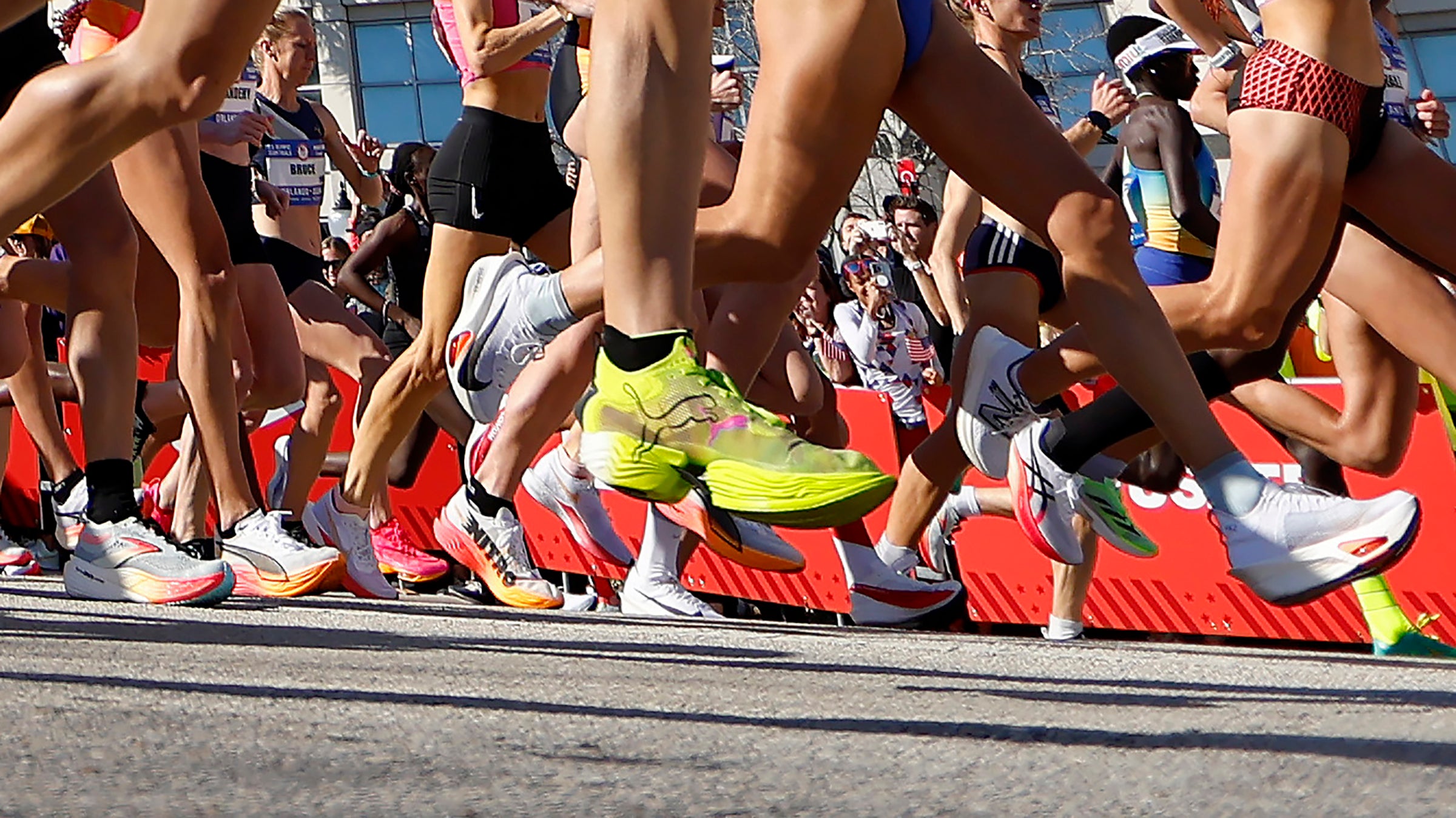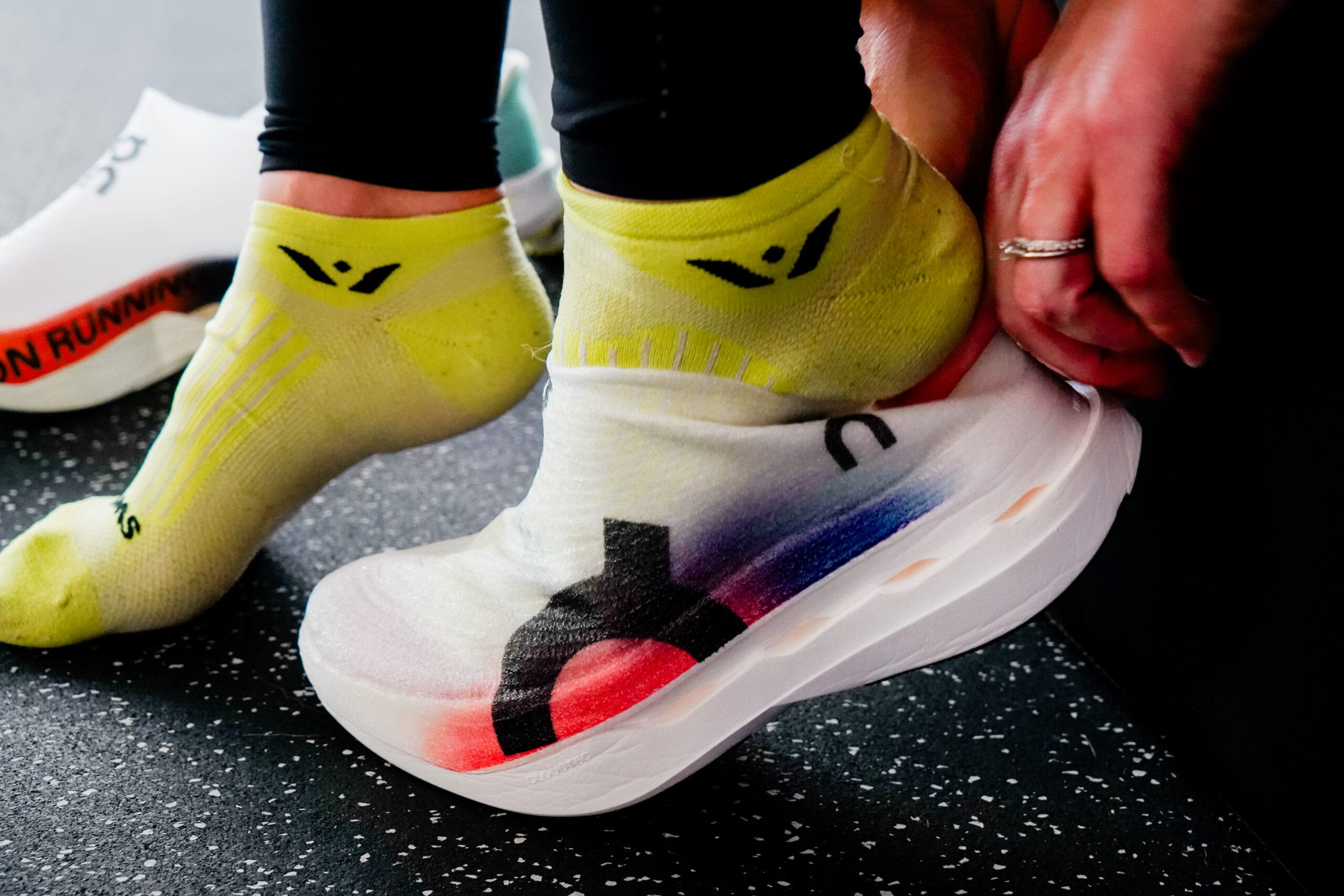Are Your Feet Strong Enough for Super Shoes? Here’s How to Get Them Ready

No elite runners would toe the line today without their super shoes. (Photo: Mike Ehrmann/Getty Images)
Massive leaps in shoe technology have revolutionized high-performance footwear over the past five years. Yes, we’re talking about super shoes. The number of runners racing in carbon-plated shoes jumped a staggering 14 percent just from 2023 to 2024, according to data from Strava.
It’s a no-brainer; why wouldn’t you want the same gear that the best runners in the world wear to break records in every event from the 5K to the marathon? Not to mention that in addition to the performance benefit of a propulsive carbon plate and improved running economy, super shoes may also expedite recovery thanks to reducing muscle damage.
For any runner looking to boost performance and avoid injury, the key is to find the right footwear—“and that’s different for everyone,” says John Mercer, a professor of kinesiology at the University of Nevada, Las Vegas, and co-director of UNLV’s Sports Research and Innovation Initiative. “Why is it different? It’s based on the way they’re built, their foot shape, how long their legs are, how much they weigh, their experience with running, the biomechanics, their pace—all of these factors have to be considered.”
RELATED: This Type of Running Shoe Is Most Likely to Injure You
When it comes to finding the super shoes that work best for you, the biggest factor is comfort, according to a 2021 meta-analysis published in Sport & Exercise Medicine & Health. Sure, a lot of that has to do with how comfortable the shoe feels out of the box. But comfort can also be acquired by strengthening your feet.
No matter what shoe you’re wearing, “it’s important for runners to make sure their feet are able to support them from the ground up,” says Jessie Duppler, a physical therapist at Chain Reaction Physical Therapy in Prescott, Arizona. But due to the way they’re designed, that’s especially important when it comes to super shoes—whether you’re wearing them to race or train.
Why You Need Foot Strength for Super Shoes
Research has yet to indicate that super shoes cause injury. But there’s growing evidence linking them to a number of issues.
“Super shoes are built to do all the things our feet do, only better,” Duppler says. “Our feet already come with built-in shock absorbers and the ability to propel us forward, but if our body can get away with not working too hard to perform these functions…it often will.”
The rigidity of a carbon plate itself can pose a problem. One 2023 paper published in Sports Medicine linked wearing carbon-plated running shoes to an increased risk of navicular bone stress fractures due to “novel biomechanical demands on the foot and lower extremities.” “Part of that may be that the carbon plate is too stiff to bend for some people, and that ends up putting more stress on certain parts of the foot,” Mercer says. “You have to apply enough force to bend the carbon plate in order for it to recoil and provide that performance benefit”—which may actually require more energy, even though these shoes claim to reduce the energetic cost of running.
In addition, super shoes often have an exaggerated toe spring, the upward curve at the front of the shoe that helps tip you forward with each step. That design allows your foot muscles to engage less than they would in flatter-soled shoes, according to a 2020 study published in the journal Scientific Reports.
“When a shoe reduces the demand on muscles, they adapt by getting weaker,” Mercer says. Weakness in those foot muscles can lead to issues like plantar fasciitis, shin splints, soft-tissue injuries in the lower leg, bone stress injuries, and even low back or knee problems.
RELATED: 9 Exercises to Make Your Big Toe Work Better
And there’s the towering slabs of midsole foam runners have to contend with underfoot, whether there’s a plate or not. While higher stack heights provide extra cushioning and energy return, these maximal shoes (counterintuitively) come with a higher vertical average load rate and vertical instantaneous loading rate—both of which promote overuse injuries like stress fractures and plantar fasciitis, research published in 2015 in Medicine and Science in Sports and Exercise suggests.
Plus, higher stack heights mean less stability. “So it’s important to make sure your ankles are strong before transitioning to a shoe with higher stack height,” Duppler says.
Ultimately, running in super shoes, research has shown, changes your form. ”When you change the way you run,” Mercer says, “that may cause new stress to be placed on a structure that isn’t normally exposed to that stress, which can lead to an injury.”

How to Prep Your Feet for Super Shoes
Don’t let these drawbacks discourage you from wearing super shoes, when appropriate. Just like you gradually increase your running volume in training, you need to ease into this type of training tool.
“Utilizing over-engineered shoes without making sure our feet are strong is like depending on a lifting belt to squat 200 pounds the first time you step in a gym,” Duppler says.
Sure, the belt may help you successfully pick those 200 pounds up. But it’s not going to prevent injury. Instead, you need to build up to that weight. Likewise, Mercer advises runners to give their bodies time to react to the new shoe stimulus. “Maybe you run a mile in them one day, and then go back to your regular trainers the next day, and then you build your volume in them from there,” Mercer says.
Regardless of shoe type, runners who rotated between multiple shoe models had a 39 percent lower risk of running injury than those who almost always ran in the same shoes, a 2015 study published in the Scandinavian Journal of Medicine & Science in Sports found.
It’s really a matter of introducing a new stressor and letting your body figure out how to adapt to it. Far too often, runners are impatient and want to run five miles in a new shoe straight out of the box, or they’re overcautious and want to avoid putting too much mileage on their new race shoe before race day, so they reserve them for just one long run. “At that point, you’re just welcoming an injury,” Mercer says.
Foot Strengthening Exercises to Prepare for Super Shoes
OK, now that we’ve gone over the importance of finding the right super shoe for you and building up into wearing them routinely, how do you strengthen your feet to withstand their demands?
“The best way to prepare for using a super shoe is to make sure your foot knows how to do its job on its own,” Duppler says. “It’s like getting a super expensive manual car but never learning how to drive stick shift—you’re leaving performance potential on the table.”
Incorporating these five foot-strengthening exercises into your training program can help ensure you’re ready to fully engage the power of your super shoes—and prevent injury.
Arch Raises
Why you should do them: “These help train the intrinsic muscles of the feet to support the arch, which needs to be strong to act as a rigid lever to push off of when we run,” Duppler says.
Perform 10–15 repetitions per foot, doing 2–3 sets.
- Stand (or sit) barefoot with your feet hip-width apart. Without curling your toes, slowly lift the arch of your foot by pressing your big toe and heel into the ground. Your toes should remain relaxed. Pause for 3-5 seconds.
- Release the arch back to a neutral position with control—don’t let it collapse.
Bent Knee Calf Raises
Why you should do them: “When we bend our knees, it disadvantages the large muscle, the gastrocnemius, and encourages the body to strengthen the smaller muscles, like the soleus, underneath—these muscles play more of a role in fine-tuning the control and motion of the foot, improving stability at both the ankle and the foot,” Duppler says.
Repeat for 10–15 reps, 2–3 sets.
- Stand with your feet hip-width apart and slightly bend your knees. Keep your core engaged and maintain a straight posture.
- Press through the balls of your feet and lift your heels as high as possible while keeping your knees bent. Focus on using your lower calves.
- Lower your heels back down with control, keeping your knees bent the entire time.
Toe Raises
Why you should do them: “The muscles in the front of the shin help to pull our feet up into what is called dorsiflexion; they also control the progression of the leg over the foot when we run,” Duppler says. “Strengthening these muscles helps improve ankle range of motion and helps your body progress through your stride.”
Repeat for 5-10 reps per foot, 2-3 sets.
- Stand with feet hip-width apart and spread your toes out naturally. Keep your weight evenly distributed.
- Press toes two to five into the ground while lifting only your big toe. Hold for two seconds, keeping the small toes relaxed.
- Switch Toe Positions. Press your big toe down while lifting toes two to five. Hold for two seconds, making sure not to let your foot roll inward (no pronation). That’s one rep.
Active Toe Extension
Why you should do them: “We need 40 to 60 degrees of toe extension to appropriately push off our foot when running or walking,” Duppler says. “A lot of us lack the ability to isolate and actively perform this motion, and this exercise helps teach us how to regain that movement.”
Repeat for 5-10 reps per foot, 2-3 sets.
- Stand with feet hip-width apart and place a rubber band under the bases of the big toes. The band isolates the big toe extensor and prevents you from rolling the foot to the outside.
- Try to lift and extend just your big toes without lifting any of the others.
Single-Leg Hops
Why you should do them: Single-leg hops develop the explosive power in the muscles of the legs and hips you need for running, Mercer says. This kind of low-grade plyometric move will also improve balance and stability in each leg.
Repeat for 5-10 reps per foot, 2-3 sets.
- Start in a standing position and shift your weight to your left foot, bringing your right knee up and bending your left arm behind you, as if in a running position.
- Bend your left knee and hop upwards, swinging your left arm forward. Land on the ball of your left foot and quickly hop upwards again.
- Complete all reps on one leg, then switch legs.